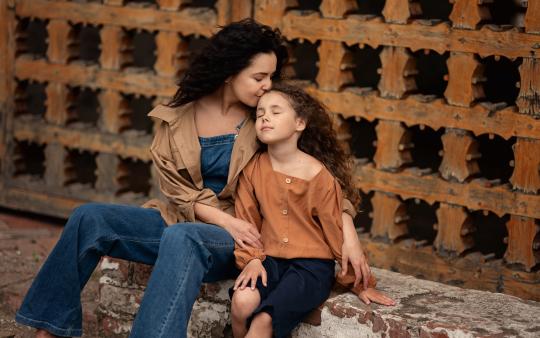Kids deal with a myriad of stressors and stress-response triggers. These may be physical, such as extreme temperatures, environmental, such as pollution, or situational, arising from interpersonal conflict, school, or team pressures. The effects of stress may be short or long term, but the longer the exposure, the more the body must adapt in order to cope with the changing needs of chronic stress. Honouring our children’s experiences, learning to recognize how stress manifests in kids, and arming them with the tools to deal with these challenging feelings can dramatically affect how large a role stress plays in their lives.
When children experience long term stress, their adrenal glands, which regulate stress, don't get a break. They become less resilient and effective, resulting in physical signs of poor coping. This breakdown leads to a weakening of all the other intricately connected systems in the body, such as the immune system. A common scenario might be coming down with a cold or flu after a period of intense work or school-related stress. Once the stress of the situation is resolved, the adrenal glands take a break and the other systems that have been suffering fail, thus permitting the virus to flourish.
Is Your Child Feeling Overstressed?
Responses to stress are unique to the individual, and may present differently from one child to the next, but some of the most common manifestations include:
-
angry outbursts, mood swings, irritability
-
depression, anxiety
-
tummy aches, diarrhea
-
skin rashes
-
headaches
-
bedwetting
-
unexplained pain
-
sleep issues: trouble falling asleep, oversleeping, teeth grinding
-
forgetfulness, inability to concentrate
-
lack of appetite, binging, unexplained nausea
-
racing heart
While these symptoms may have other root causes, stress tends to aggravate everything. Identifying the source of the tension is key, which is why communication is the best way to figure it out. Sometimes the cause of stress may be obvious—for instance, living through a pandemic—but sometimes it's something the parent might not even realize, such as feeling left out by a peer group, or fear about the future. The only way to find out is to keep the lines of communication open and judgement-free.
11 Ways to Help Your Child Deal With Anxiety
Communicating and providing some of the following stress management techniques can go a long way in helping your little one become better at coping with life’s ups and downs!
Fresh Air
Fresh air and movement are necessary for everyone! If there is one thing I encourage in my practice, it’s to get outside and move your body every single day, regardless of the weather! Screen time must be balanced with a healthy dose of fresh air and movement. It doesn't have to be complex or involve special equipment. Just go for a walk, play tag, follow the leader, ride a bike, or play frisbee or catch!
Laughter
Laughter is truly the best medicine and can have an immediate effect on mood. Play a family game of “try not to laugh” or kick it up a notch by playing outside, where one person takes a big sip of water and holds it in their mouth while the other person tries to make them laugh. If they spit, they win (or lose, depending on how you play the game)!
Deep Breathing
Deep breathing can help bring things back into focus. Teach your child to breathe deeply, pushing the belly out with each deep breath. Inhale for 5 counts, and exhale for 10, to really blow all the stress away. For little ones, have them practice blowing out imaginary birthday candles.
Grounding
Grounding is a great trick when things seem out of control. Try a “3-3-3” exercise: stop, look around, and find and name three things you can see, hear, and feel. This can bring someone in the throes of a panic attack back down to reality and works well in a crisis.
Sleep
Sleep is key for growth, emotions, and resiliency. Ideally, school-aged kids, including teens, should get 8 to 12 hours nightly. If your child is having trouble falling or staying asleep, seek the help of your healthcare provider.
Herbal Medicine
Herbal teas and tinctures with calming properties can be a great tool when used appropriately. Chamomile, catnip, hops, skullcap, lemon balm, linden, and oats are soothing and highly nutritive for the nervous system, and make a wonderful nighttime stress-relieving ritual. Don’t offer a large serving too close to bedtime to avoid middle-of-the-night pee breaks!
Essential Oils
Essential oils such as lavender can be helpful for promoting calm. Add a few drops to a spray bottle with water, pop on a label that reads “Chill Out Spray” or “Monster Begone”, and watch the magic work as you spritz it around your child’s room!
Food
Food can both help and hurt the way our bodies respond to stress. When we go too long without eating, or overindulge in simple carbs like bread, pasta, and sweets, we can experience dips in blood sugar that make the body believe it’s in danger of starvation. Including a protein and fat every time you eat can help. Not only do these help prevent blood sugar imbalances, they also banish the dreaded “hangries”! If necessary, a protein-rich snack before bed, like a handful of pumpkin seeds or nuts, can help satiate hungry children, and get them ready for sleep.
Bathtime
Bathtime is the perfect opportunity to elevate your relaxation game. Add a drop of lavender and some soothing Epsom salts for even more chill.
Supplements
Supplements like rhodiola, l-theanine, GABA, and magnesium are all potential choices that can promote restful relaxation and calming without sedation. Chronically stressed kids may need deeper interventions under the guidance of their healthcare practitioner.
Mindfulness
Mindfulness can have an incredibly positive effect on improving emotional resilience and self-regulation. For a fun visual, create a “mind in a jar” with your child. Fill a lidded mason jar with water (add a couple drops of food colouring for fun, if desired). Explain that this is the mind during a quiet moment, clean and clear like the sky. Take some sparkles (sand or soil will work too!) and add it to the jar. Each tiny grain represents a thought: some are happy, some are sad, some are exciting wishes, and some are dark and angry feelings. Put the lid on the jar and shake it up, so that everything swirls around, faster and faster. This is the mind in a jumble! Last, let everything calm down by letting the jar sit still. Explain that this is the mind in meditation. Watch the thoughts settle down to the bottom, leaving the water—or “mind”—light and clear, instead of whirling and swirling. The jar shows how one can act peacefully, because they can think clearly! Any time your child needs to settle their thoughts, they can get the jar and watch the sparkles settle while their mind does the same.
You might also enjoy: How Can You Tell the Difference Between Stress and Anxiety?, The Emotional Roots of Anxiety in Children, and Ashwagandha: Essential in Your Parental Toolbox for Managing Stress.









